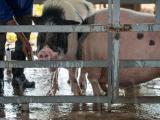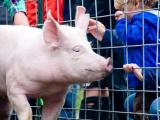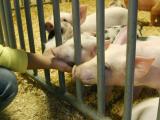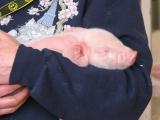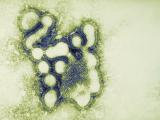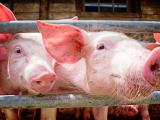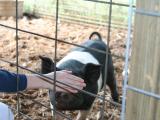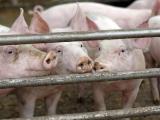Aug 9, 2012 (CIDRAP News) – The number of recent human cases of swine-origin variant H3N2 influenza (H3N2v) in recent weeks climbed to 152 today as Illinois reported its first case and Indiana announced more infections.
Meanwhile, scientists said the novel virus appears to be largely linked to pigs being raised by children for showing at exhibitions.
At a media briefing today to address the steep rise in cases, led by big increases yesterday in Indiana and Ohio, the CDC said the flurry of new cases is partly the result of a change in reporting requirements. State labs that confirm H3N2v cases can now report them directly without waiting for CDC confirmation.
However, Joe Bresee, MD, medical epidemiologist in the CDC's Influenza Division, told reporters that the quickly mounting number of cases is real, with investigations in several states linking cases to agricultural fairs and pig exhibitions, which are popular this time of year. Streamlining state reporting of new H3N2v cases allows "a more real-time view of how the situation is evolving in states," he said.
For example, Indiana today reported seven more cases, pushing the national total to 152 after Bresee confirmed 145 recent cases during the briefing. The Indiana State Department of Health (ISDH) said in a statement that it confirmed its first two cases in Tippecanoe County, raising the number of affected counties to 19.
Today's CDC total includes the first case from Illinois. The patient is a child who attended the Coles County Fair, got sick last week, and has not been hospitalized, according to a press release today from the Illinois Department of Public Health (IDPH). The case pushes the number of affected states to four, with Hawaii having confirmed a case Jul 31.
The number of new cases will change, Bresee said, even daily, as each state reports its newly confirmed cases. However, starting tomorrow the CDC will issue H3N2v updates every Friday.
Bresee said more than 90% of the H3N2v infections are in children who have direct contact with pigs, such as raising and showing them at fairs, he said. Other cases involved indirect exposure, such as being in swine barns or other pig environments.
The CDC has said it expects to see more cases, with state and county fair seasons still in full swing now, especially in the Midwest. For example, the Iowa State Fair starts today, and the Minnesota State Fair begins Aug 23.
At state and county fairs, it's not unusual to see children and their families spending long hours in swine barns, tending the animals and waiting to show their animals. Swine barns are also popular exhibits for fairgoers, who enjoy catching glimpses of, for example, the winner of the "biggest pig" contest or mother pigs with their newborn piglets.
The high burden in kids might suggest that adults have some cross-protection from earlier exposure to similar strains, Bresee said. CDC researchers are exploring cross-protection issues and are conducting genetic sequencing tests on the positive samples states are submitting. Bresee said that so far scientists are seeing a high degree of genetic similarity among the H3N2v strains.
Bresee also said that as yet no sustained human-to-human infections have been reported, though the CDC expects to see some limited spread, given that three of last year's H3N2v infections that occurred in children who had contact with each other but no known pig exposure.
There's no appreciable risk in people who aren't exposed to pigs, Bresee said. "This is not a pandemic situation."
Most infections have been mild and self-limiting, with symptoms resembling seasonal flu. So far two hospitalizations have been reported; both patients are recovering and have been discharged.
Given the high risk of flu complications to people with underlying medical conditions, including with H3N2v, Bresee said the CDC advises elderly people, young children, and those with chronic medical conditions to avoid pig exposure at fairs. He also said the CDC urges people who are exposed to pigs in fair settings to wash their hands frequently and to avoid eating or bringing food into the settings.
The CDC hopes that the prevention steps will slow the pace of new cases and at this point does not recommend that states cancel pig exhibitions.
Some severe infections have occurred, and Bresee said healthcare workers who suspect H3N2v in a patient with underlying conditions institute treatment with oseltamivir (Tamiflu) or zanamivir (Relenza).
Ohio swine testing
Though there's not a lot of data on how common novel H3N2 is in fair pigs this summer, the CDC's epidemiologic picture seems to square with preliminary findings that a group from the Ohio State University (OSU) is seeing as they travel to county fairs testing pigs for influenza A.
Two members of the team told CIDRAP News today that they have found only the novel H3N2 virus in pigs this year, at levels consistent other viruses found in previous years. Many of the pigs testing positive for the virus are connected with young people who raise them noncommercially for exhibitions. Richard Slemons, DVM, principal investigator, said, "We're looking at this niche."
The county fair testing project at OSU's Animal Influenza Ecology and Epidemiology Research Program (AIEERP) launched in 2009 after the 2009 H1N1 virus jumped from humans to pigs. The project is part of the Minnesota Center of Excellence for Influenza Research and Surveillance (MCEIRS), which receives federal funding though a national CEIRS network supported by the National Institute of Allergy and Infectious Diseases of the National Institutes of Health (NIH).
(MCEIRS is a program within the University of Minnesota's Center for Infectious Disease Research and Policy, publisher of CIDRAP News.)
The Ohio State group coordinates its work with the Ohio Department of Health and the Ohio Department of Agriculture, and it shares representative isolates with the National Veterinary Services Laboratory and the US Department of Agriculture (USDA) for testing and sequencing.
Slemons said he and his colleagues first became interested in testing pigs for influenza A at country fairs in 1988 after one of the veterinary students picked up a swine influenza infection at an Ohio fair. When the 2009 H1N1 virus jumped from humans to pigs in the early months of the pandemic, "we dusted off the old research proposal," he said.
One member of the research group, Andy Bowman, DVM, had been conducting influenza A testing on pigs at country fairs in Ohio in 2007 where he detected and reported two human swine influenza cases—both of whom had direct contact with pigs in connection with a county fair in Huron County.
The research team travels to several fairs each summer, sampling 20 to 40 pigs from different parts of swine barns, examining swine barn animals for illness symptoms, and sharing information about swine influenza prevention with fair board members. County fair administrators have been very helpful, Slemons said. "They're interested in being proactive in protecting public health and swine."
Slemons and Bowman spoke with CIDRAP News just before departing for their next testing task, squeezing in sampling at three more county fairs within 12 hours.
They virus types changed in fair pigs over the 4-year testing period. In 2009, the group found H1N2 and H3N2 swine influenza viruses. Then in 2010, their tests yielded the H3N2 swine influenza strain. In 2011, they found H1N2 in their samples again along with H3N2, and both strains had the matrix gene from the 2009 H1N1 virus. That year, no human illnesses were linked to the pigs they tested. So far this summer, they've detected only H3N2 with the former pandemic virus' matrix gene.
The pigs testing positive for the virus do not have any clinical symptoms, Slemons and Bowman said, with isn't unusual but makes it difficult for people visually screening the pigs at fairs to tell if the animals are infected and pose a threat to humans.
Members of the research team have presented their findings at scientific meetings, which have been attended by representatives from the CDC, USDA, and NIH. Slemons and Bowman said the project's purpose is to provide a basis for making evidence-based decisions.
A spokesperson for the Indiana State Board of Animal Health said this week that 29 of 30 pigs that were tested in connection with three recent county fairs had H3N2v. At one of those fairs, in LaPorte County, some of the pigs showed clinical symptoms, according to an earlier report.
See also:
Aug 9 CDC press briefing transcript
Aug 9 IDPH statement
Aug 9 ISDH press release
Aug 8 CIDRAP News story "Variant H3N2 cases surge in Indiana, Ohio"
Aug 7 CIDRAP News story "H3N2 found in most pigs tested following human cases"
Jul 25 CIDRAP News story "Four novel H3N2 cases linked to pigs in Indiana"
OSU AIEERP swine influenza A monitoring program background
